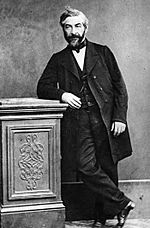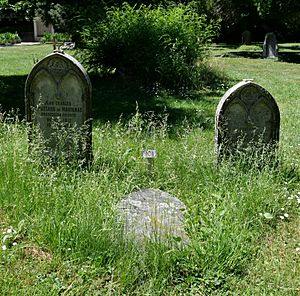Jean Charles Galissard de Marignac facts for kids
Quick facts for kids
Jean Charles Galissard de Marignac
|
|
|---|---|
 |
|
| Born | 24 April 1817 Geneva, Switzerland
|
| Died | April 15, 1894 (aged 76) Geneva, Switzerland
|
| Known for | Measurement of atomic weights Discovery of ytterbium Codiscovery of gadolinium |
| Awards | Davy Medal (1886) |
| Scientific career | |
| Fields | Chemistry |
Jean Charles Galissard de Marignac (born 24 April 1817 – died 15 April 1894) was a famous Swiss chemist. He studied the atomic weights of elements. His work helped scientists understand isotopes. These are different forms of the same element. He also studied rare earth elements. He discovered ytterbium in 1878. He also helped discover gadolinium in 1880.
Many people thought he was one of the greatest chemists of his time. He was especially good at inorganic chemistry. This is the study of chemicals that don't come from living things. In 2011, his old laboratory in University of Geneva became a historical chemical landmark in Switzerland.
Contents
Early Life and Education
Jean Charles Galissard de Marignac was born in Geneva, Switzerland. His birthday was April 24, 1817. His father, Jacob Galissard de Marignac, was a judge. His mother, Susanne Le Royer, was the sister of a well-known chemist. This chemist, Elie Le Royer, had a pharmacy. It was in the same building where Jean Charles lived.
Marignac went to the École polytechnique in Paris. He wanted to become a mining engineer. From 1837 to 1839, he studied at the École des mines. After that, he spent a year traveling. He visited many famous scientists. He worked for a short time with Justus von Liebig. He also worked with Alexandre Brongniart at a porcelain factory. He may have also learned from Jöns Jacob Berzelius.
Career and Discoveries
When Marignac returned home, he became a chemistry professor. This was in 1841 at the Academy of Geneva. In 1845, he also became a professor of mineralogy. He taught both subjects until 1878. He stopped working then because of poor health.
He continued to work in a lab at his house. He did this until 1884. By then, he was too sick to work. Marignac passed away in Geneva on April 15, 1894.
Measuring Atomic Weights
Marignac is famous for carefully measuring atomic weights. He always used at least two different ways to check his results. He did this for both old and new elements. He wanted to test Prout's hypothesis. This idea suggested that atomic weights were simple multiples of hydrogen's weight. Marignac helped set exact values for many elements. This was very important for inorganic chemistry.
Discovering New Elements
Marignac spent a lot of time studying rare earth elements. It was hard to separate and identify them. In 1878, he found ytterbium. He extracted it from something that was thought to be pure erbia. In 1880, he found gadolinium and samarium. These were found in samarskite earths.
Other Chemical Work
In 1858, Marignac noticed something important. He saw that fluostannates and fluosilicates were similar in shape. This helped him figure out the makeup of silicic acid. His research also helped confirm the atomic weights of zirconium and titanium.
Later, Marignac studied fluorides of other elements. These included boron and tungsten. He also made silicotungstic acid. This was one of the first examples of a complex inorganic acid.
Marignac also found a way to separate niobium and tantalum. He used a process called fractional crystallization. This method was used in industry for many years.
Physical Chemistry Studies
Marignac also did a lot of research in physical chemistry. He studied how solutions work. He looked at how much heat was made when salt solutions were diluted. He also studied how the specific heat of salt solutions changed. This depended on temperature and how much salt was in them. He also looked at how liquids spread out, a process called diffusion.
Jean Charles Galissard de Marignac is buried in Geneva. He rests with his wife, Marie, and their son, Edouard. Their grave is in the Cimetière des Rois. This cemetery is seen as a special resting place for important people in Geneva.


